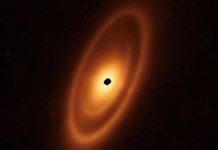
CHARLOTTESVILLE, Va., Dec. 21 (UPI) — A new study suggests the stellar material swirling around a very young protostar is pulling in magnetic fields from its surroundings.
By analyzing these twisting magnetic fields, researchers may be able to gain new insight into the formation of young stars.
The latest discovery — detailed in the Astrophysical Journal — was made possible by the National Science Foundation’s Karl G. Jansky Very Large Array radio telescope, often called VLA for short. The VLA allowed researchers with the National Radio Astronomy Observatory to analyze the alignment of radio waves emitted by gas and dust being pulled into the swirling stellar disk.
The waves’ alignment, or polarization, show the formation and movement of magnetic fields in the region surrounding the young star.
“The alignment of magnetic fields in this region near young stars is very important to the development of the disks that orbit them,” study author Leslie Looney, an astronomer at the University of Illinois, said in a press release. “Depending on its alignment, the magnetic field can either hinder the growth of the disk or help funnel material onto the disk, allowing it to grow.”
The star of note is NGC1333 IRAS 4A. It’s found 750 light-years away in the constellation Perseus, and is estimated to be just 10,000 years old. Its mass is believed to be roughly twice that of our own sun.
One of two stars forming within a cloud of stellar material, the newly born star has effectively become a guinea pig for the analysis of tangling magnetic fields.
For the first time, astronomers have revealed the region surrounding a protostar where the structure of magnetic fields begins to look different from those farther away — where fields pulled into from afar twist and interact with those closer to the newborn star.
“Our VLA observations are showing us this region, where the change in shape of the magnetic field is taking place,” said co-author Erin Cox, also with the University of Illinois.
The new data also shows that millimeter- to centimeter-sized particles are abundant in the stellar disk — bigger than astronomers expected, suggesting particles accumulate rather quickly in the disk of young star.






